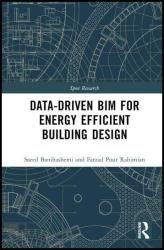 Название: Data-driven BIM for Energy Efficient Building Design
Название: Data-driven BIM for Energy Efficient Building DesignАвтор: Saeed Banihashemi, Hamed Golizadeh
Издательство: Routledge
Год: 2023
Страниц: 187
Язык: английский
Формат: pdf (true)
Размер: 14.0 MB
This research book aims to conceptualise the scale and spectrum of Building Information Modelling (BIM) and Artificial Intelligence (AI) approaches in energy efficient building design and develop its functional solutions with a focus towards four crucial aspects of building envelop, building layout, occupant behaviour and heating, ventilation and air-conditioning (HVAC) systems. Drawn from the theoretical development on the sustainability, informatics and optimisation paradigms in built environment, the energy efficient building design will be marked through the power of data and BIM intelligent agents during the design phase. It will be further developed via smart derivatives to reach a harmony in the systematic integration of energy efficient building design solutions; a gap which is missed in the extant literature and this book aims to fill that. This approach will inform a vision for future, provide a framework to shape and respond to our built environment and how it transforms the way we design and build. By considering the balance of BIM, AI and energy efficient outcomes, the future development of buildings will be regenerated in a direction that are sustainable in the long run. This book is essential reading for those in the AEC industry as well as computer scientists.
In recent decades, several approaches, including linear, non-linear, heuristic and metaheuristic methods, have been developed based on AI as the alternatives for traditionally mathematical methods. Great trust in AI is the development of algorithmic models to assist with optimisation theory and its applications in refining data and automatically finding the most optimum choices. In principle, AI applications in engineering problems can be categorised into three main areas:
- Prediction
- Classification
- Optimisation
Prediction and classification are two relatively similar methods of pre-processing data analysis used to describe important classes of data or to predict future data trends. However, while classification is usually used to classify categorical data, prediction models continuous-valued functions. Hence, these techniques need training data first to learn and, second, to infer the results based on inputs. ANN, DT and fuzzy systems are among the popular AI methods used for these purposes.
Furthermore, optimisation methods can be applied and considered a postprocessing data step to achieve the best option among different choices. It is an iterative procedure that compares various solutions until an optimum or satisfactory resolution is found (28). Well-known used methods like GA and particle swarm optimisation (PSO) are inherent in mimicking biological systems and are appropriate for multivariable and non-linear problems.
Academics and professionals have employed AI in sustainable construction for the following aims:
- Forecasting. Different studies have been conducted to forecast electrical loads of utilities, short-term and long-term energy use, weather variables and thermal load for buildings. Typically, conditional demand analysis (CDA), ANN and support vector machine (SVM) are used for forecasting because of their strong prediction capability.
- System modelling. ANN and fuzzy logic are often used for modelling various engineering systems in buildings such as HVAC, which can find an authentic relationship between inputs and outputs. ANN can be used for both continuous and discrete variables, but fuzzy logic is used for continuous ones.
- Optimising. Finding the most optimum values and states for different building design and operation problems is a real risk that AI can mitigate. Subsequently, evolutionary algorithms including GA and PSO are widely used for optimising building envelopes, massing, thermal comfort, daylighting and lifecycle analysis.
BIM-compatible EED involves the first generation of building energy simulation software, including EnergyPlus, DOE2, ESP-r and Modelica, which are considered as ‘not BIM aware applications’ due to the lack of an intimate relationship with a BIM authoring tool. The second level of adopting BIM into EED can be labelled as BIM-integrated EED, mainly characterised by the direct integration between BIM authoring applications and energy simulation software. Specifically, three groups – geometrical, topological and semantic – that contain the information required for an energy analysis assessment are integrated with the second generation of building performance simulation tools: IES, DesignBuilder, Trnsys 17, eQuest, Autodesk Ecotect and Riuska. These applications are ‘BIM aware’ as to the capability of making API (Application Programming Interface) calls to BIM authoring tools and extracting the information directly from the BIM model.
The current trend in applying BIM-EED processes and creating an industry-based structure for an energy efficient built environment result in committing and competing for the stage of BIM-EED adoption phases, which, in turn, embarks on BIM-inherited EED. This level of implementation focuses on delivering a strategic value of coherent and structured digital information of a project together with a package of building performance simulation. This category of BIM, which is adopted into EED, is internally interoperable through utilising the inbuilt information and includes Autodesk GBS, Autodesk Formit 360, Graphisoft EcoDesigner and Bentley AECOsim Energy Simulator.
As mentioned in the previous sections, various simulation software applications are employed in BIM-EED adoption levels for building performance simulation purposes. EnergyPlus, DOE 2 and Modelica are the most popular software among the tools categorised as the first group, BIM-compatible EED. EnergyPlus is a simulation engine imputing and outputting text files to calculate heating and cooling loads in a variable point of time.
Скачать Data-driven BIM for Energy Efficient Building Design